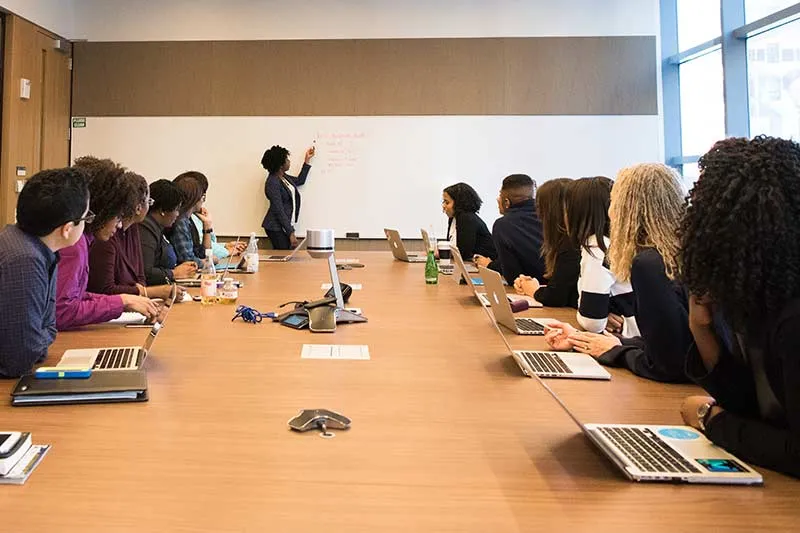Best Practices for Employee Training

Employee training has a lot in common with your very first days at school…
What do you remember from school as a child? Was it fingerpainting or playing in the schoolyard?
What about in the classroom? Addition, the alphabet, singing songs?
Perhaps a little of everything, but this was all made possible because at some point you learned how to listen.
When you listened to your teachers you were rewarded with compliments and feedback.
When you listened to your peers you learned about their likes and dislikes, their struggles and their desires. When popular interests shifted or people left for different schools, you learned how to process this event and adjust for the new challenge.
Eventually, you learned that listening was the first step towards communicating with your peers and solving problems.

Running a successful business really isn’t much different. Especially when it comes to training new staff when all of the sudden your company grows organically or goes through M&A activities.
When your business is growing and expanding, and you have to deal with a new office abroad, you need to consider the challenges that accompany the positive aspects of an expanding business. Adhering to local laws and regulations, adjusting business strategy to meet the demands of the local market and keeping communication aligned are just a few of the items for consideration in order to prepare for a successful start.
While there are many critical business decisions to make to get your new unit up and running, it can be easy to overlook the most important aspect of the business – the people working there!
Before making changes, take a moment to consider the resources you will need to provide for your new group of talented individuals in order for them to succeed.
In this article, we will identify some of the main challenges your business might face when attempting to scale quickly during expansion.
After we cover the challenges, we will provide tips on:
- creating a supportive learning environment for your employees
- how to effectively implement a modern employee training solution to get your business up to speed without pushback

Table of Contents
Standardizing and Localizing in Training and Development
The Golden Arches Method
Why is it important to standardize and localize your business procedures and onboarding efforts?
By standardizing and localizing your business processes, you will be able to effectively communicate your message across the globe. Here is one example of how this works:
you arrive in Japan for the first time. You don’t know a word of Japanese and you are starving. You see the familiar golden arches and decide to head inside.
While browsing the menu, you see some items you have never heard of before. Teriyaki Burger? McShrimp Burger? What are those?
You notice some of the locals are ordering these items. You decide to try it. Hey, they taste pretty good! Now how did McDonald’s know these items were going to be successful on the menu in Japan?
Besides extensive R&D and years of market research, McDonald’s actually followed a very simple procedure: they have standardized their brand image making it almost impossible to mistake no matter where you are in the world, while adjusting their menus to satisfy the local market.
Needless to say, people are still “lovin’ it”.
The same can happen for your employees. If, on the one hand, you really need to make sure your brand message, value, and corporate identity are aligned all around the globe, little details and minor adjustments can be modified in order to match local expectations, traditions, and culture.
Companies that managed to successfully run operations abroad are companies that aren’t afraid to hire local teams and that rely on these teams when it comes to partially adjusting their approach.

Digitalization and the Rise of Remote Workers
By adjusting your work processes in the same manner, you may also be able to address the rising group of remote workers.
Who are these individuals? Are they working on the next universal remote so that I can get rid of the 5 remotes I have at home?
No, unfortunately not.
For the past few years, we have seen a dramatic increase in remote employment. High rent prices in big cities affecting both the employer for the workspace and the employee for the living space, the increased amount of time commuting to and from work, as well as the struggle to balance parenthood and a career have all become factors that ultimately drove businesses to offer remote employment as functional option in certain business sectors.
And thanks to the advancement of broadband internet, the power of video calls allows you to be present at any video conference, no matter your location.
According to a Gallup report, in a group of employed Americans 43% stated that they had spent “at least some time working remotely” in the last year.
Although this group may be working in a pants-optional workspace, your business will still need to present the same message and ensure they will have the same onboarding experience as if they had all their clothes on and were sitting with you in the office.
Considering that this modern, mobile, occasionally fully-clothed workforce will need to be able to access the same amount of information at any point in time, you will need to collaborate with necessary teams beforehand in order to present centralized and well organized documentation to maintain consistency with your overall business strategy.

Shaping Your Communication with Technology
Communication is key, as you may know. However, communication in the workplace is critical for the future success of your business.
One aspect that should be considered in all of your communication outlets is to not only incorporate technology into the message but also embrace technology as a support beam structured carefully to hold weight to your company message.
One example we see often is that of an employee training session.
This session may consist of a two day on-site meeting with video content, email follow ups, whiteboard sessions, product presentations and open discussions. Some resources could be available for new hires online in a resource document, but after that, they are on their own.
This collection of information is often difficult for employees to keep track of and more often than not, becomes outdated as soon as the next training session rolls out.
Consequently, the recurring issues that arise during onboarding that prevent an employee from being fully operative and up to speed are:
- Not understanding their tasks
- Asking questions to understand their tasks
- Spending time researching questions
- Not understanding the culture
How can we avoid running into these roadblocks? How can we prevent these issues from arising before it is too late?
We no longer expect all business decisions to be made in person. The person-to-person, please sign on the bottom line, firm handshake, conference room situation is no longer the only way we can do business.
Ironically, unifying communications across different business units while acknowledging digitalization needs a human approach in order to be effective.
This is also true for the way we onboard and train our employees. Think of them as eager students preparing for their final exams. Except this time it affects a larger group of individuals with different backgrounds and experiences all taking the same test.
So how can we scale properly to fit your growing business?

Does it Scale? Employee Training during Expansion
An important question indeed.
Employee training and development has gone through many changes in the past decade. Digital transformation has paved the way for the future of work which addresses the many painpoints in employee training and development.
As I mentioned earlier, some of the main issues that occur during employee onboarding are the lack of automation and the quick expiration of relevant information due to continuous updates.
Different processes can be optimized and automated. For example employee training. New employees need to familiarize themselves with different aspects of the new company culture, new tasks, and responsibilities. On top of that, they also need to become highly skilled at dealing with processes and new software solutions. One way to automate software training is implementing a performance support system such as on-screen interactive guides for software. Such an interactive electronic performance support system provides real-time, step-by-step guidance that creates a positive employee experience.
Employees will spend large amounts of time learning new software or refreshing their memory on their previous knowledge. This is why elearning solutions are effective in a growing company; not only is your business developing, so are your processes and the software tools used to work internally, and your staff needs to quickly adapt to the changes.

Another reason why contextual help represents a great solution for a growing group of employees is because you can always make quick adjustments to address different user groups.
For instance, when setting up user guides internally, you could create separate user journeys linked to separate employee experiences for those who are complete beginners in the software application they need to use and those who come with more experience. Think of this as graduating at the top of the class, you wouldn’t want to waste your time learning the basics again if you already graduated.
Being able to onboard and scale quickly puts your business at the forefront of innovation. By considering the changes in the workplace, you are proactively giving your new employees the support they need and expect. This is a positive way to empower your employees without the additional costs of training.
It is necessary to provide practical training methods for your teams to be onboarded and fully operative in a reasonable amount of time. Don’t underestimate the importance of laying the groundwork of support for your employees; they are the backbone of the business and will need continuous care in order to perform at high level.

Conclusion
Learning and developing in the workplace is a process that never ends, and nor would you want it to!
What we have seen in the recent years is a demand for more automated training. Training tools such as employee training software address the weaknesses of a standing training session, thus, by having a more innovative training approach, you are preemptively avoiding the long spiral of frustration, discontent, and eventual loss your employee to another company.
When you focus on the development of your employees, you are putting them in a winning position, thus putting your business in a winning position.
Think about how much effort your company focuses on a positive customer success experience.
You constantly listen to customer feedback to provide the best customer experience possible. By taking this standard for your customers and applying it internally, you will be able to see immediate results in your employee development during the expansion of your business.

